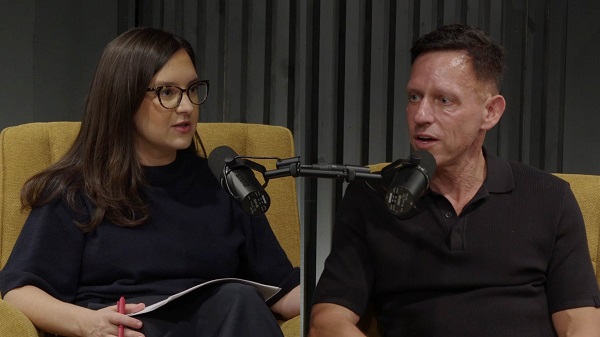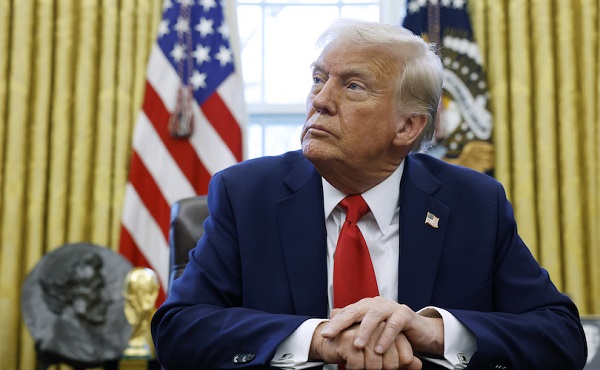International
Independent Media “The Free Press” hits 1 Million subscibers

Free Press founder Bari Weiss interviews Peter Thiel
| By Bari Weiss |
The rise of The Free Press happened simply and honestly: story by story.
Christmas and Hanukkah celebrate otherworldly miracles. But this Chrismukkah—the holidays fell on the same day this year—we at The Free Press added a miracle of an entirely human kind. We reached one million subscribers.
Grateful—and hopeful—doesn’t begin to cover it.
I have been beaming since Wednesday morning, when I refreshed my screen and got the good news in Nellie’s childhood home. (We captured the moment; this was before I cried.) Mostly I’m pinching myself, thinking back to how this all began, and wondering how we got here.
The easy answer would be: Americans’ faith in the legacy press has collapsed, with curious and independent-minded readers unsubscribing from The New York Times, pausing their donations to NPR, and searching for trustworthy alternatives.
And that’s certainly part of what happened. It was definitely the beginning.
But we quickly discovered that you can’t build something new—or certainly not something lasting—based only on rejecting the old. You have to build something people value. Something people need.
At The Free Press, that something is the truth—the only goal of real journalism. That’s what we’ve run hard and fast toward. From day one, we’ve had a single guiding principle: Pursue the truth and tell it plainly. No shortcuts. No exceptions.
From day one, we’ve been reporting stories the legacy media was scared to touch or had overlooked as a result of its incuriousness, politesse, or entrenched interests. We’ve aimed to pair the political freedom of the new world with the professed standards of the old. And because we’ve been a subscription business from the start, we’ve been liberated from the need to please advertisers or get clicks. That’s allowed us to do ambitious journalism, driven by a desire to bring our readers great work that informs them about the world as it is.
We’ve done all this very lean. We don’t have hordes of consultants, mammoth business teams, or special strategies for ranking on social media or Google. Until a few weeks ago, we didn’t even have a metered paywall, let alone a product manager.
And when I say we—I don’t just mean our editorial team, which is the hardest working in the industry. I mean all of us. All one million, especially those who have been here from our earliest days.
Back then, honestly, a paid subscription didn’t get you anything so different from a free one. Now we’ve expanded to offer a whole fleet of content and events and podcasts. Soon, we’ll have even more. But our early subscribers didn’t sign up when we had any of that. They believed deeply in the mission, and that belief allowed us to grow.
In other words: there were no fancy tricks. The rise of The Free Press happened simply: story by story. Podcast by podcast. Debate by debate. Video by video. Interview by interview. And subscription by subscription.
As I’ve told our newsroom on more than one occasion: There is no secret business—no gaming or cooking app, for now at least. The business is the stories we tell. If a story is excellent, if it tells our readers something new, something revelatory, if it explains something in a new way, if it deepens trust, we will grow. If it doesn’t do these things, we won’t. Our readers are discerning: They love and reward quality.
This is all a way of saying: We reached this milestone because of you.
The Free Press began as a question I asked myself after resigning from The New York Times, scratching my head at what I saw there. Is there still a market for real journalism? For fearless, fair, independent journalism that treats readers like adults? Journalism that presents the facts—even the uncomfortable ones—and allows people to draw their own conclusions?
The answer, it turns out, is a resounding yes.
That “yes” from one million of you—and counting—has given me hope not just for journalism but for the future.
So here’s to you, the first million members of the Free Press community. Here’s to the next million. And most important of all: Here’s to the next story.
In honor of this milestone, we’re offering a 25% discount to become a paying member of our community. If you’re a free subscriber, there’s never been a better time to upgrade. We’re keeping this sale on annual subscriptions going until midnight ET on December 31, 2024, because we want many, many more of you to join us, officially, in 2025.
If the price—less than $80 a year—is prohibitive, please write to us: [email protected] and put “subscription help” in the subject line.
Technically my assignment for today was to choose my favorite stories of 2024. All week long we’ve been recommending the best of The Free Press. Today was my day. Honestly, I found it an impossible task. But if you’re still wondering what makes The Free Press tick, or if it’s worth supporting our work by becoming a paid subscriber, allow me to recommend . . .
1. Uri Berliner would never describe himself as brave, but I will. His bombshell essay, “I’ve Been at NPR for 25 Years. Here’s How We Lost America’s Trust.,” captured how the public radio network lost its way—and shaped conversation for months. If you want to understand why The Free Press is an urgent project, read this.
2. One of the best things to happen to The Free Press this year was my friend Niall Ferguson joining us as a columnist. Start with his inaugural and provocative essay, “We’re All Soviets Now.”
3. Abigail Shrier is one of the most important reporters working today. We were thrilled that she officially joined as a contributing editor this year. Her recent investigation—“The Kindergarten Intifada”—exposes a widespread, pernicious campaign in American public schools to indoctrinate children against Israel.
4. Free Press columnist Coleman Hughes is a generational talent: cool-headed, hyper-rational even as he touches the hottest subjects in our politics and culture. His review essay of Ta-Nehisi Coates’s new book, The Message, is definitive: “The Fantasy World of Ta-Nehisi Coates.”
5. In “They’re Black Democrats. And They’re Suing Chicago Over Migrants,” our reporter Olivia Reingold reminded Americans that you can never, ever make assumptions about what any cohort of voters thinks or believes.
6. And in “I’m 28. And I’m Scheduled to Die in May,” Rupa Subramanya illustrated, in harrowing detail, why a mentally ill person would end her own life in a country where death is seen as a cure.
7. Douglas Murray’s Sunday column, “Things Worth Remembering,” is a weekly jewel. I particularly loved this one, about what makes a great conversationalist: “Conversation Is an Art.”
8. Maddy Kearns’s story on British citizens getting arrested for silently praying was one of the most troubling dispatches I’ve read on the perilous state of free expression in the West: “She Was Arrested for Praying in Her Head.”
9. Not only does she deliver TGIF every week, but Nellie Bowles somehow managed to write a book this year. This excerpt—“The Day I Stopped Canceling People”—is a deeply personal account of going along with the crowd before realizing other things, like love, are more important than fitting in.
10. The Free Press decamped to Israel earlier this year to report from the ground. But our man in Jerusalem, since the start of the war, had been Matti Friedman. Don’t miss his piece “Why I Got a Gun,” a sobering tale of how terror transformed a family.
Beyond the Best of The Free Press, here’s what summed up my 2024. . .
Best thing I read this year: The World of Yesterday by Stefan Zweig.
Best thing I watched: Ratatouille! This is the first—and only—movie our daughter has seen. We watch it in 10-minute increments, so I don’t yet know how it ends. Highly recommend the movie—and this methodology.
Best thing I heard: Beyonce’s Cowboy Carter. And I don’t know if this quite qualifies, but I’m also going with the Roast of Tom Brady. Cultural glasnost, brought to you by Netflix. The beginning of the great un-freezing.
Best thing I bought: These $45 jeans from Amazon. Are they flattering? Absolutely not. But you will not find more comfortable pants.
Best thing I ate: This Alison Roman recipe, which I make in a tagine, never fails. Also: Courage Bagels in LA are worth the wait.
Biggest regret of the year: Not pausing to celebrate wins. And every bedtime I missed because of work. Resolutions, both.
Best thing that happened: The birth of our gorgeous (enormous) son in July.
New Year’s resolution: Become a Pilates mom.
What I am most looking forward to in 2025: Building The Free Press—and spending time with the talented, tireless people I get to build it alongside.
International
Trump puts new price tag on Canada joining “Golden Dome”

Quick Hit:
President Trump has upped the cost for Canada to join the U.S. “Golden Dome” missile defense program to $71 billion—$10 billion more than his previous ask.
Key Details:
- Trump confirmed the new $71 billion figure while speaking to reporters aboard Air Force One.
- Canada has pushed back, with PM Mark Carney and diplomats calling Trump’s offer a “protection racket.”
- Trump said Canada could access the system for free if it became the 51st U.S. state.
Diving Deeper:
President Trump has put a new and steeper price on Canada’s potential entry into America’s “Golden Dome” missile defense program. Speaking from Air Force One on Monday, Trump told reporters, “They want to be in… Seventy-one billion they’re going to pay.”
That’s a $10 billion increase from the $61 billion figure Trump had previously floated, marking a sharp escalation in his negotiations with Ottawa. The Golden Dome, described by the administration as a “state-of-the-art” defense shield, aims to protect North America from a new era of missile threats—particularly those posed by China, Russia, and North Korea.
Trump has framed the Golden Dome as the long-awaited realization of Ronald Reagan’s “Star Wars” vision, using space-based sensors and interceptors to strike down incoming ballistic, cruise, or hypersonic missiles. Development timelines suggest full deployment is still 5–7 years off, but an initial $25 billion is already allocated in next year’s defense budget. The entire project may run upwards of $175 billion, with some estimates as high as $542 billion over 20 years.
Canada, which has long partnered with the U.S. under NORAD to detect airborne threats, has expressed interest in joining the project. But Trump is demanding a separate, costly buy-in. He reiterated that Ottawa would “have to pay a lot of money” to participate unless it pursued a full political union with the U.S. “It would be free if Canada became the 51st state,” he added.
Canadian leaders have pushed back hard. Prime Minister Mark Carney, re-elected in April after campaigning against U.S. interference, said Canada wants to protect its citizens but not under terms dictated from Washington. Ambassador to the U.N. Bob Rae went further, calling Trump’s offer a “protection racket.”
conflict
Trump dismisses US intelligence that Iran wasn’t pursuing nuclear bomb before Israeli attack

From LifeSiteNews
By Dave DeCamp
When asked about Tulsi Gabbard’s assessment, President Trump said, ‘I don’t care what she said. I think they’re very close to having [a nuclear weapon].’
Ahead of Israel’s attacks on Iran, U.S. intelligence assessed that Iran was not pursuing nuclear weapons and that even if it chose to do so, it would take up to three years for Tehran to be able to produce and deliver a nuclear bomb against a target of its choosing, CNN reported on Tuesday, citing people familiar with the intelligence.
The U.S. assessment goes against the claims from Israeli Prime Minister Benjamin Netanyahu, who launched the war under the pretext of preventing Iran from obtaining a nuclear weapon. But President Trump appears to be taking Israel’s word over his own intelligence agencies, as he told reporters that he didn’t care about his director of national intelligence’s assessment on the issue.
In March, DNI Tulsi Gabbard said that “Iran is not building a nuclear weapon and Supreme Leader Khamenei has not authorized the nuclear weapons program he suspended in 2003.” Her assessment was reflected in the Intelligence Community’s annual threat assessment.
When asked about this assessment, President Trump said, “I don’t care what she said. I think they’re very close to having [a nuclear weapon].”
Netanyahu claimed in an interview on Sunday that he shared intelligence with the U.S. that Iran could have developed a nuclear weapon within months or a year, although that was not the conclusion of U.S. intelligence agencies, based on the CNN report. But even based on Netanyahu’s own timeline, the U.S. would have had time to continue negotiations with Iran.
Israel attacked Iran two days before another round of negotiations between the U.S. and Iran was set to be held. Trump had been demanding that Iran eliminate its nuclear enrichment program, which was a non-starter for Tehran. Despite the apparent impasse, Iran was set to present a counter-proposal to the U.S., but the talks were canceled after Israel launched its war.
Reprinted with permission from Antiwar.com.
-

 Alberta23 hours ago
Alberta23 hours agoAlberta health care blockbuster: Province eliminating AHS Health Zones in favour of local decision-making!
-

 Crime2 days ago
Crime2 days agoUK finally admits clear evidence linking Pakistanis and child grooming gangs
-

 conflict1 day ago
conflict1 day agoTrump: ‘We’ have control over Iranian airspace; know where Khomeini is hiding
-

 Health2 days ago
Health2 days agoLast day and last chance to win this dream home! Support the 2025 Red Deer Hospital Lottery before midnight!
-

 Alberta14 hours ago
Alberta14 hours agoAlberta pro-life group says health officials admit many babies are left to die after failed abortions
-

 Business2 days ago
Business2 days agoCarney praises Trump’s world ‘leadership’ at G7 meeting in Canada
-

 Daily Caller14 hours ago
Daily Caller14 hours ago‘Not Held Hostage Anymore’: Economist Explains How America Benefits If Trump Gets Oil And Gas Expansion
-

 Alberta14 hours ago
Alberta14 hours agoCentral Alberta MP resigns to give Conservative leader Pierre Poilievre a chance to regain a seat in Parliament





